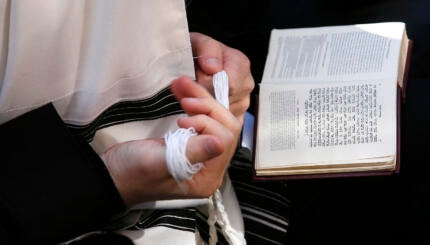To understand the newest book by Rabbi Avi Weiss one needs to tell a story that appears in the book,
Holistic Prayer
:
A rabbi was once informed that a crazed woman was in the beit midrash (the study hall, which is sometimes used as a small prayer room). “She is standing in front of the Ark, the Ark is open, and she is babbling and gesturing wildly,” he was told. “She seems to be mentally imbalanced. Perhaps you can go in and help her. The rabbi went in. As he sat quietly in the back, he could see that the woman was deeply immersed in tefilla. The rabbi overheard some of her words as she swayed and cried out: “Dear God, I know I was here just last week, but I am back because I need your help. My daughter is still not well. Please, please, in my hour of need, do not forsake me, do not leave me!” Understanding the privacy of her tefilla, the rabbi left the woman alone. Upon his return, he was asked, “So what did you do with the babbling crazy lady?” The rabbi responded, “This morning I got up, put on my prayer shawl, donned my tefillin and davened. But this woman wasn’t davening, she was talking to God. That’s a whole different world.” (Holistic Prayer, pg. 169)
The goal of Rabbi Weiss’ book is to take the reader on a journey. It is a journey that when finished will lead the reader to transition from a davening (praying) out of repetition to a conversation with God. The book is most appreciated by those who have a familiarity with the mechanics of daily Jewish prayer and have a comfort with the key terminology. It is to this audience that Rabbi Weiss challenges the reader to rethink what they think they know about prayer and to open up our hearts and minds to a reinvigorated and renewed understanding. For example, in discussing a key feature of traditional Jewish prayer, the set times allocated for it, Rabbi Weiss explains:
“The idea that love is predicated on action is crucial to understanding tefilla and, more broadly, all of Jewish ritual. If tefilla is an expression of love, why should we be mandated to pray? Why not pray only when we feel like praying? In truth, however, we may not feel like praying for long periods of time. But if we’re obliged to pray, we make a decision to pray. By placing ourselves in the prayerful mode, feelings of prayer may surface… That is the basic idea of ritual. Ritual is an expression of our love for God. Its goal is by and large to do an action from which feelings may come. (pg. 77)”
In this journey of Holistic Prayer Rabbi Weiss weaves together a myriad of sources and references. His book is filled with ideas sourced from the Talmud, Halakha (Jewish law), Tanakh (Hebrew Bible) and other traditional places. Yet, it also brings in ideas from thinkers not accustumed to finding themselves referenced in a work of the philosophy of prayer by an Orthodox rabbi. Examples of these out of the box thinkers include: John Powell, the Jesuit priest and author of
The Secret of Staying in Love
; the humanist philosopher Erich Fromm and the American playwright, Thornton Wilder. In the bringing together the wisdom from classical Jewish tradition and the larger world, Rabbi Weiss exemplifies the very best of the Modern Orthodox approach, in the model set forth by his teacher, Rabbi Joseph Soloveitchik zt”l.
I had the unique privilege of being a student in the rabbinical school he founded, Yeshivat Chovevei Torah, while he was conducting his research that would become this book. In our year-long class on prayer Rabbi Weiss would convey his ideas and philosophy with us that would later fill the pages of Holistic Prayer. In reading this book I can not help but bring that experience to bear in my understanding this work. I not only read the words but I can hear them and visualize his excitement, passion and genuineness in conveying them.
In the preface Rabbi Weiss shares that his wrote this book because “for a long time, I have lovingly struggled with prayer.” When I read those words I had a hard time relating to them because as a student of his, someone who has been blessed to know him for almost 10 years, I have never experienced the man who has “lovingly struggled with prayer,” rather, I know a man who has a face that lights up when he is in the midst of prayer and who sways with an extraordinary amount of devotion and commitment. I think that is because this book is as personal for him as it is intellectually rigorous and spiritually rich. It records his own journey through his adult life with prayer. As someone who has at times also struggled with prayer I can very much share in that experience and it only makes this work more important for me and others who experience ups and downs in their own personal prayer life.
I believe this book is a must read for anyone who has committed to taking part in the life of traditional Jewish prayer, or who has ever experienced it, with all of its rigors and demands. It will inject your prayer life with a breath of fresh air and reframe the whole endeavor to provide new possibilities for enrichment and connection to God.
In closing the book Rabbi Weiss offers the following prayer:
“May the tefilla of Rabbi Judah HaLevi — of God and the human being searching for each other — be forever ingrained in our hearts.
I have sought your nearness, With all my heart I have called You, And going out to meet You, I found You coming toward me. (pg. 260)”
May we take up the call of Rabbi Weiss and catalyze our prayer to be a moment of going out to meet the Divine and in so doing discover God coming out to meet us.



